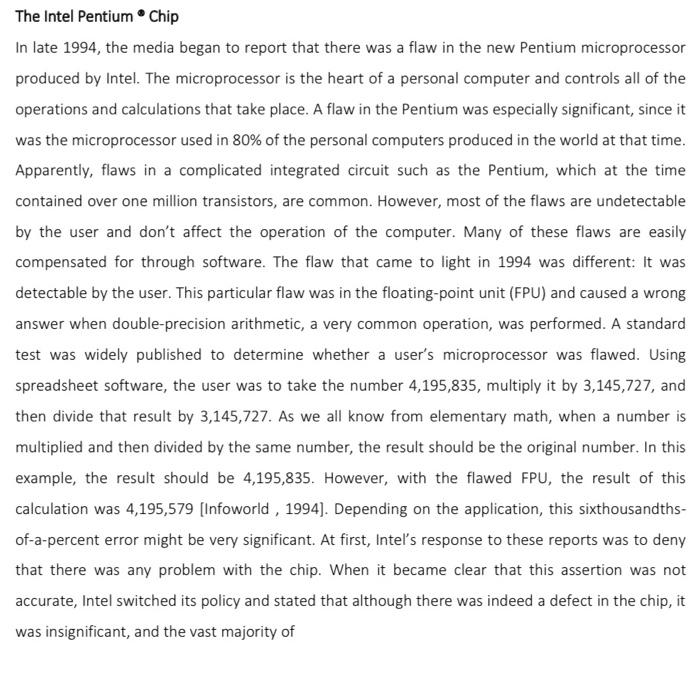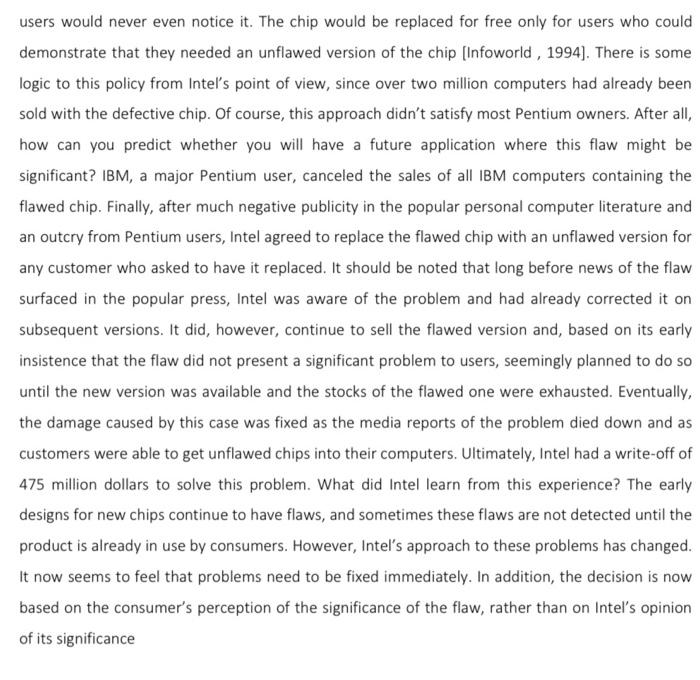First: - Read the Intel Pentium Chip case study see the PDF file attached Second: - Use line drawing technique to get some insight into this problem. Start by defining the problem and the positive and negative paradigms. In addition, give five more hypothetical examples. Draw the line and put all the examples on the line. Problem: Positive Paradigms: Negative paradigms: 5 hypothetical examples: The Intel Pentium Chip In late 1994, the media began to report that there was a flaw in the new Pentium microprocessor produced by Intel. The microprocessor is the heart of a personal computer and controls all of the operations and calculations that take place. A flaw in the Pentium was especially significant, since it was the microprocessor used in 80% of the personal computers produced in the world at that time. Apparently, flaws in a complicated integrated circuit such as the Pentium, which at the time contained over one million transistors, are common. However, most of the flaws are undetectable by the user and don't affect the operation of the computer. Many of these flaws are easily compensated for through software. The flaw that came to light in 1994 was different: It was detectable by the user. This particular flaw was in the floating-point unit (FPU) and caused a wrong answer when double-precision arithmetic, a very common operation, was performed. A standard test was widely published to determine whether a user's microprocessor was flawed. Using spreadsheet software, the user was to take the number 4,195,835, multiply it by 3,145,727, and then divide that result by 3,145,727. As we all know from elementary math, when a number is multiplied and then divided by the same number, the result should be the original number. In this example, the result should be 4,195,835. However, with the flawed FPU, the result of this calculation was 4,195,579 (Infoworld , 1994). Depending on the application, this sixthousandths- of-a-percent error might be very significant. At first, Intel's response to these reports was to deny that there was any problem with the chip. When it became clear that this assertion was not accurate, Intel switched its policy and stated that although there was indeed a defect in the chip, it was insignificant, and the vast majority of users would never even notice it. The chip would be replaced for free only for users who could demonstrate that they needed an unflawed version of the chip [Infoworld , 1994). There is some logic to this policy from Intes point of view, since over two million computers had already been sold with the defective chip. Of course, this approach didn't satisfy most Pentium owners. After all, how can you predict whether you will have a future application where this flaw might be significant? IBM, a major Pentium user, canceled the sales of all IBM computers containing the flawed chip. Finally, after much negative publicity in the popular personal computer literature and an outcry from Pentium users, Intel agreed to replace the flawed chip with an unflawed version for any customer who asked to have it replaced. It should be noted that long before news of the flaw surfaced in the popular press, Intel was aware of the problem and had already corrected it on subsequent versions. It did, however, continue to sell the flawed version and, based on its early insistence that the flaw did not present a significant problem to users, seemingly planned to do so until the new version was available and the stocks of the flawed one were exhausted. Eventually, the damage caused by this case was fixed as the media reports of the problem died down and as customers were able to get unflawed chips into their computers. Ultimately, Intel had a write-off of 475 million dollars to solve this problem. What did Intel learn from this experience? The early designs for new chips continue to have flaws, and sometimes these flaws are not detected until the product is already in use by consumers. However, Intel's approach to these problems has changed. It now seems to feel that problems need to be fixed immediately. In addition, the decision is now based on the consumer's perception of the significance of the flaw, rather than on Intel's opinion of its significance Indeed, similar flaws were found in 1997 in the early versions of the Pentium II and Pentium Pro processors. This time, Intel immediately confirmed that the flaw existed and offered customers software that would correct it. Other companies also seem to have benefited from Intel's experience. For example, Intuit, a leading manufacturer of tax preparation and financial software, called a news conference in March of 1995 to apologize for flaws in its TurboTax software that had become apparent earlier in that year. In addition to the apology, they offered consumers replacements for the defective software. Use line drawing to get some insight into this problem. Start by defining the problem and the positive and negative paradigms. In addition, give five more hypothetical examples. Problem: Positive Paradigms: Negative paradigms: hypothetical examples: 1- 2- 3- 4- 5- First: - Read the Intel Pentium Chip case study see the PDF file attached Second: - Use line drawing technique to get some insight into this problem. Start by defining the problem and the positive and negative paradigms. In addition, give five more hypothetical examples. Draw the line and put all the examples on the line. Problem: Positive Paradigms: Negative paradigms: 5 hypothetical examples: The Intel Pentium Chip In late 1994, the media began to report that there was a flaw in the new Pentium microprocessor produced by Intel. The microprocessor is the heart of a personal computer and controls all of the operations and calculations that take place. A flaw in the Pentium was especially significant, since it was the microprocessor used in 80% of the personal computers produced in the world at that time. Apparently, flaws in a complicated integrated circuit such as the Pentium, which at the time contained over one million transistors, are common. However, most of the flaws are undetectable by the user and don't affect the operation of the computer. Many of these flaws are easily compensated for through software. The flaw that came to light in 1994 was different: It was detectable by the user. This particular flaw was in the floating-point unit (FPU) and caused a wrong answer when double-precision arithmetic, a very common operation, was performed. A standard test was widely published to determine whether a user's microprocessor was flawed. Using spreadsheet software, the user was to take the number 4,195,835, multiply it by 3,145,727, and then divide that result by 3,145,727. As we all know from elementary math, when a number is multiplied and then divided by the same number, the result should be the original number. In this example, the result should be 4,195,835. However, with the flawed FPU, the result of this calculation was 4,195,579 (Infoworld , 1994). Depending on the application, this sixthousandths- of-a-percent error might be very significant. At first, Intel's response to these reports was to deny that there was any problem with the chip. When it became clear that this assertion was not accurate, Intel switched its policy and stated that although there was indeed a defect in the chip, it was insignificant, and the vast majority of users would never even notice it. The chip would be replaced for free only for users who could demonstrate that they needed an unflawed version of the chip [Infoworld , 1994). There is some logic to this policy from Intes point of view, since over two million computers had already been sold with the defective chip. Of course, this approach didn't satisfy most Pentium owners. After all, how can you predict whether you will have a future application where this flaw might be significant? IBM, a major Pentium user, canceled the sales of all IBM computers containing the flawed chip. Finally, after much negative publicity in the popular personal computer literature and an outcry from Pentium users, Intel agreed to replace the flawed chip with an unflawed version for any customer who asked to have it replaced. It should be noted that long before news of the flaw surfaced in the popular press, Intel was aware of the problem and had already corrected it on subsequent versions. It did, however, continue to sell the flawed version and, based on its early insistence that the flaw did not present a significant problem to users, seemingly planned to do so until the new version was available and the stocks of the flawed one were exhausted. Eventually, the damage caused by this case was fixed as the media reports of the problem died down and as customers were able to get unflawed chips into their computers. Ultimately, Intel had a write-off of 475 million dollars to solve this problem. What did Intel learn from this experience? The early designs for new chips continue to have flaws, and sometimes these flaws are not detected until the product is already in use by consumers. However, Intel's approach to these problems has changed. It now seems to feel that problems need to be fixed immediately. In addition, the decision is now based on the consumer's perception of the significance of the flaw, rather than on Intel's opinion of its significance Indeed, similar flaws were found in 1997 in the early versions of the Pentium II and Pentium Pro processors. This time, Intel immediately confirmed that the flaw existed and offered customers software that would correct it. Other companies also seem to have benefited from Intel's experience. For example, Intuit, a leading manufacturer of tax preparation and financial software, called a news conference in March of 1995 to apologize for flaws in its TurboTax software that had become apparent earlier in that year. In addition to the apology, they offered consumers replacements for the defective software. Use line drawing to get some insight into this problem. Start by defining the problem and the positive and negative paradigms. In addition, give five more hypothetical examples. Problem: Positive Paradigms: Negative paradigms: hypothetical examples: 1- 2- 3- 4- 5










